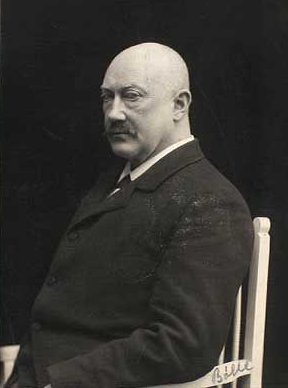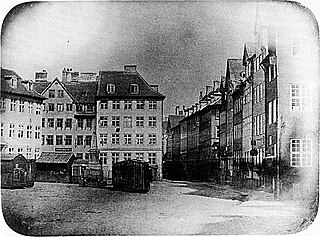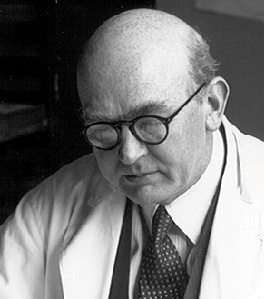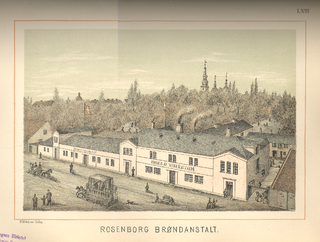
A. Michelsen was a leading Danish jeweller founded in 1841 by Anton Michelsen in Copenhagen. It was responsible for executing all Danish orders. It was absorbed by Georg Jensen A/S in 1985.

A. Michelsen was a leading Danish jeweller founded in 1841 by Anton Michelsen in Copenhagen. It was responsible for executing all Danish orders. It was absorbed by Georg Jensen A/S in 1985.

Anton Michelsen (1809–1877) was born 1809 in Copenhagen. [1] His family, which can be traced back to the 17th century, had for generations been metalsmiths. He completed a goldsmith's apprenticeship in Odense in 1839 [2] before moving to Copenhagen where he continued his training in Dyrkoph's and court goldsmith J.B. Dalhoff's workshops. He also attended the Royal Danish Academy of Fine Arts where he was influenced by Gustav Friedrich Hetsch. In 1836, he went on a long journey abroad, working in some of the leading goldsmiths' workshops in Germany and Paris. He established his own goldsmithy in Gothersgade in Copenhagen when he returned to Denmark in 1841. He immediately won the attention of the royal family. Christian VIII charged him with executing all Danish medals with title of royal court and order jeweller (kgl. hof- og ordensjuvelerer). Michelsen was the only Danish goldsmith who was represented at the Exposition Universelle in Paris in 1855. [3] In 1900, he was the only Danish jeweller to exhibit silver during the Paris Exposition. [1]

Michelsen's son Carl Michelsen (1853–1921), a jurist and merchant, continued the company when his father died in 1877. He collaborated with artists such as Arnold Krog, Harald Slott-Møller, Hans Tegner, Martin Nyrop and especially Thorvald Bindesbøll. Carl Michelsen for a while served as president of Industriforeningen and was the first chairman of the Museum of Arts and Crafts. His son, Poul Ulrich Michelsen (1881–1957), joined the company as a partner in 1914. He had received a commercial education in Landmandsbanken and continued the company alone when his father died in 1921. The artists that he collaborated with included Svend Hammershøi, Ib Lunding, Olaf Stæhr-Nielsen, Palle Suenson and Arne Bang. The most important works from the period were created in the years after 1925 to design by professor Kay Fisker. Later collaborators included Ole Hagen, Erik Herløw and Edvard Kindt-Larsen.
Poul Ulrich Michelsen was appointed to Commander of the Order of the Dannebrog in connection with the one hundred years' anniversary of the company in 1941 and the Danish Museum of Arts and Crafts arranged a retrospective exhibition.
Poul Michelsen's son, Jørgen Michelsen (born 1912), an art historian and silversmith, joined the company in 1940 and became a partner in 1943. A Swedish subsidiary, AB A. Michelsen, Stockholm, was established in 1946.
In 1985, A. Michelsen was merged with the Royal Porcelain Factory, Holmegaard Glasværk and Georg Jensen under the name Royal Copenhagen.
Anton Michelsen's workshop was originally located in Gothersgade. The company later established a factory at Sturlasgade 14 in Islands Brygge while its shop was situated at Bredgade 11.

Anton Michelsen was one of the first to work in the so-called Old Nordic style. [4]

Georg Arthur Jensen was a Danish silversmith and founder of Georg Jensen A/S.

Thorvald Bindesbøll was a Danish National romantic architect, sculptor and ornamental artist. He designed the Dragon Fountain, Copenhagen (Dragespringvandet) and is perhaps best known as the creator of the Carlsberg beer label, which has remained unchanged since it was introduced.

Danish modern is a style of minimalist furniture and housewares from Denmark associated with the Danish design movement. In the 1920s, Kaare Klint embraced the principles of Bauhaus modernism in furniture design, creating clean, pure lines based on an understanding of classical furniture craftsmanship coupled with careful research into materials, proportions, and the requirements of the human body.

The Royal Danish Academy of Fine Arts, School of Design, more commonly known as the Danish Design School is an institution of higher education in Copenhagen, Denmark, offering a five-year design education consisting of a three-year Bachelor programme and a two-year Master in design as well as conducting research within the fields of arts, crafts and design. Danmarks Designskole is an institution under the Ministry of Science, Innovation and Higher Education.

In Denmark, photography has developed from strong participation and interest in the very beginnings of the art in 1839 to the success of a considerable number of Danes in the world of photography today.

Gustav Bartholin Hagen was a Danish architect. He was the father of the architect Ole Hagen (1913-1984).
Events from the year 1854 in Denmark.
Jørgen Gammelgaard (1938–1991) was a Danish furniture designer who also designed lamps and silverware.

Jens Høyer Hansen was a Danish-born jeweller who settled in New Zealand and did most of his well-known work in Nelson, New Zealand. Hansen was one of a number of European-trained jewellers who came to New Zealand in the 1960s and transformed contemporary jewellery in the country, including Tanya Ashken, Kobi Bosshard and Gunter Taemmler.
Søren Georg Jensen was a Danish silversmith and sculptor. Son of the noted silversmith Georg Jensen, he was the artistic director of the Georg Jensen Silversmithy from 1962 to 1974.

Georg Jensen A/S is a Danish designer company with focus on silverware. It was founded by silversmith Georg Jensen in 1904.
Karen Strand was a Danish goldsmith and jewellery designer. One of the first students to study at the Goldsmiths College (Guldsmedehøjskolen) in Copenhagen, she is remembered for her simplistic style, creating chains threaded with stones. After working for the jeweller A. Dragsted, she established her own business in 1962.

Harald Nielsen was a Danish designer of silver for Georg Jensen. The younger brother of Georg Jensen's third wife, he joined the company at 17 as a chaser's apprentice but later became one of the company's leading designers in the 1920s and 1930s and Jensen's closest colleague. One of his most well-known designs being the pyramid flatware pattern. In the early 1950s he headed the company's apprentice school and in 1958 became its artistic director.

P. Ipsens Enke was a ceramics manufacturer based at Frederikssundsvej 78 in Copenhagen, Denmark. The company was founded by Peter Ipsen in 1843 and was continued by his widow Louise Ipsen and son Berthel Ipsen after his death in 1860. It achieved international success with its replica of antique Greek and Roman ceramics, winning awards at international expositions and opening its own shops in Paris and London. After the turn of the century, it collaborated with artists such as Thorvald Bindesbøll, WillumsenJ and Axel Salto. It closed in 1955.

Rosenborg Brøndanstalt was a mineral spa and mineral water factory located in Gothersgade in Copenhagen, Denmark. Rosenborg Brøndanstalt was founded on 23 March 1831 at the initiative of Jonas Collin, medical doctor Ole Bang, and Johan Georg Forchhammer to provide the citizens of Copenhagen with an alternative to visiting spas abroad. First Frederik VI and later Christian VIII contributed to the project by donating a strip of Rosenborg Castle Gardens along Gothersgade. The buildings were built to a design by royal building inspector Jørgen Hansen Koch in 1833.

Erik Magnussen was a Danish silversmith and designer. He was from 1925 to 1939 based in the United States, initially as artistic director of the Gorham Manufacturing Company in New York City and later with his own workshop in first Chicago and then Los Angeles.

HDMS Justitia was a Royal Dano-Norwegian Navy ship-of-the-line, built to a design by Henrik Gerner. Although launched in 1777, she was not fully commissioned until 1780. The British Royal Navy seized her in 1807, together with the rest of the Danish fleet after the second battle of Copenhagen. The British never commissioned Justitia. A renaming to Orford in 1809 was cancelled. She was broken up in 1817.
Birte Stenbak née Jensen is a Danish goldsmith and jeweller. After an apprenticeship with Poul Bang in the 1950s, she worked in Bent Stålgård's workshop. In 1975, together with her friend Birthe Jørgensen, she established a studio and shop in central Copenhagen, where she created imaginative jewellery consisting of gemstones, silver, gold, pearls and other materials. From 1983, she ran the business alone in what became known as Aladdin's Cave. Collaborating with the artist Tage Andersen, in 1988 she created a large table decoration for Rosenborg Castle. Since the mid-1970s, her work has been exhibited at home and abroad.

Ulrich Anton Schønheyder was a Danish naval officer.